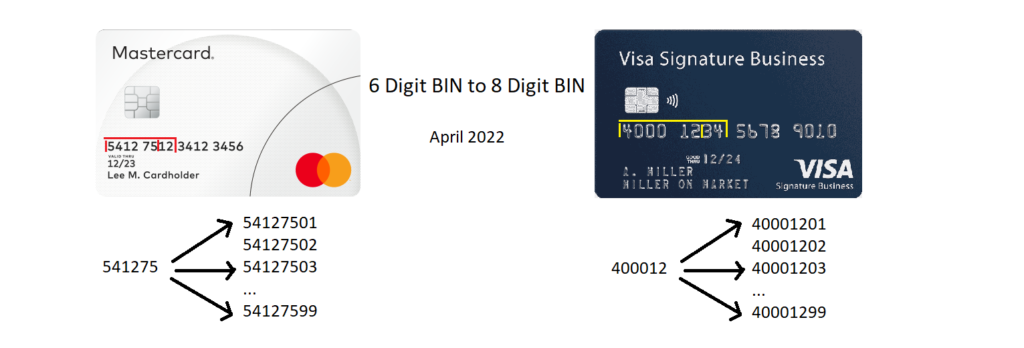🔢 Deep Dive: BIN (Bank Identification Number) in Card Payments
🧩 What Is a BIN?
BIN, or Bank Identification Number, is the first 6 to 8 digits of a payment card number. It uniquely identifies the institution that issued the card, allowing payment networks (like VisaVisa visa A leading global payment technology company connecting consumers, businesses, and banks. or MastercardMasterCard mastercard A global payments network enabling electronic transactions between banks, merchants, and cardholders.) to route transactionsTransactions transactions Interactions where value is exchanged for goods or services. accurately between acquirers, issuers, and processors.
In 2022, BINs expanded from 6 digits to 8 digits as part of a global shift led by ISO and card schemes to address the growing demand for unique BINs driven by the rise of fintechs, virtual cards, and digital walletsDigital Wallets digital-wallets Applications or platforms (like Apple Pay, Google Pay) that store payment card data securely and allow users to pay digitally..
🧭 BIN Structure Example (Pre-2022 and Post-2022)
| Card Number | Digits 1–6 | Digits 1–8 | What It Means |
|---|---|---|---|
4212 34XX XXXX XXXX | 421234 | 42123456 | Identifies issuerIssuer issuer A bank or financial institution that issues payment cards to consumers. Responsible for authorizations and chargebacks. bank, scheme, and product |
5378 65XX XXXX XXXX | 537865 | 53786572 | Mastercard credit card from issuer X |

🧑🏫 Who Assigns BINs?
BINs are assigned and managed by card schemes under ISO/IEC 7812. These are the same entities responsible for regulating the card network:
- Visa BIN Info
- Mastercard BIN Services
- American Express BIN Info
- Discover BIN Guidelines
- UnionPay BIN Info
📋 Common Card Schemes and BIN Ranges
| Card Scheme | Typical Starting DIGITS | BIN Range Reference | Examples |
|---|---|---|---|
| Visa | 4 | Visa BIN Range | 400000–499999 |
| Mastercard | 51–55, 2221–2720 | Mastercard BINs | 530000, 540000 |
| American ExpressAmerican Express american-express A global financial services corporation offering credit cards, charge cards, travel-related services, and merchant acquiring. | 34, 37 | Amex Support | 370000, 340000 |
| Discover | 6011, 65, 644–649 | Discover BIN Migration | 601100, 651000 |
| UnionPay | 62 | UnionPay | 622126–622925 |
| JCB | 35 | JCB Official | 352800–358999 |
💳 BIN Types by Card Product
Different types of cards use specific BINs depending on their functionality and risk profile:
| Card Type | Common Use Case | BIN Type |
|---|---|---|
| Credit | Borrowing line extended by issuer | BINs flagged as credit in scheme directory |
| Debit | Linked to a checking/current account | BIN flagged as “DDA”/debit |
| Prepaid | Gift cardsGift Cards gift-cards Prepaid cards issued by retailers or card networks that allow purchases up to the value loaded on the card., travel cards, fintechFintech fintech Short for financial technology, refers to tech-enabled innovation in financial services. walletsWallets wallets See Digital Wallets. | BINs with prepaid flag set |
| Virtual | Wallets, app-based BNPL, one-time-use | Often fall under existing credit/debit BINs with subranges |
Note: The BIN database also contains metadata such as country, currency, card level (Classic, Gold, Platinum), and issuer name.
⚙️ How BINs Are Used in the Payments Flow
- Transaction Routing:
When a card is swiped or entered online, the acquirerAcquirer acquirer A financial institution or payment processor that manages the merchant account, enabling businesses to accept card payments. Acquirers receive all transactions from the merchant and route them to the appropriate issuing bank. or gatewayGateway gateway A service that authorizes and processes card payments for online merchants. Examples include Stripe, Adyen, and PayPal. reads the BIN and sends the transaction to the correct card network. - Risk Scoring & FraudFraud fraud
Criminal deception involving unauthorized payments or use of financial credentials. Prevention:
Fraud detection engines use BINs to check geolocation, card type, and risk flags. - BIN SponsorshipBIN Sponsorship bin-sponsorship
An arrangement where a financial institution allows another party to use its Bank Identification Number for issuing cards. (BaaS):
Many fintechs use a BIN sponsor—a licensed issuer who leases BIN access under regulated arrangements. - MerchantMerchant merchant
An individual or business that accepts payments in exchange for goods or services. Decisioning:
Merchants may apply rules (e.g., decline prepaid cards for subscriptions) based on the BIN. - Regulatory & Tax Mapping:
BIN data helps identify the issuing country to determine VAT/tax or apply cross-border fees.
🧠 Quick BIN Tips for Payments Professionals
- Always check BIN metadata for compliance, especially in cross-border or regulated markets.
- If issuing new cards via BaaS, secure a dedicated BIN or BIN range for better control.
- Use BIN intelligence tools (e.g., Binlist, Mastercard’s MRS, Visa’s VMM) to enrich transactions and reduce fraud.
🔚 Conclusion
BINs may look like just a few digits, but they’re a foundational element in how modern card payments work. From routing and risk scoring to product definition and partner arrangements, understanding the BIN ecosystem is critical for anyone in fintech, acquiring, or card issuance.
As the ecosystem continues to expand—with 8-digit BINs, virtual cards, and embedded finance—mastering BIN logic is essential for smooth, compliant, and secure payment operations.
Would you like me to add a downloadable BIN lookup table or a sample BIN routing flowchart as part of this post?

Vibhu is a global payments leader and PhD researcher in real-time payments, dedicated to making payments simpler, smarter, and more inclusive. With 20 years of payments experience across Citibank, Adyen, IKEA, Snapdeal, iPayLinks — and markets spanning India, China, Southeast Asia, Europe, and Australia— he brings a truly global perspective to the future of money. Vibhu is also the founder of PaymentsPedia.com, a knowledge hub where he shares insights on cards, crypto, cross-border flows, and real-time rails.📧 vibhu@paymentspedia.com | LinkedIn
